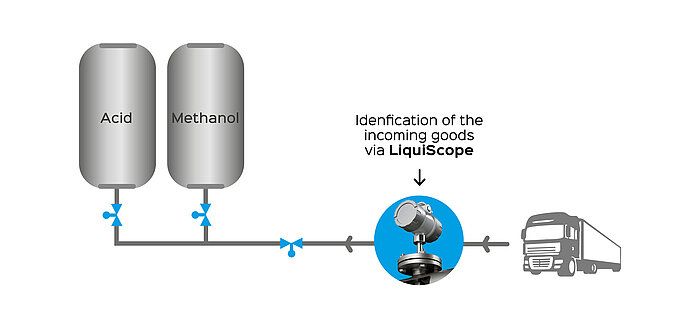Liquid identification in tank farms // Incoming goods inspection
LiquiScope – Your solution to avoid misloading and make processes safer
Why LiquiScope?
In Tank farms, Tank terminals and in hazardous material storage every correct allocation of liquids counts. Even small mix-ups can cause expensive damage and pose dangerous risks to people and the environment. With LiquiScope you get a high-precision system for liquid identification, which is based on sound velocity measurement based:
- Prevent misloading: Detect early whether the delivered liquid is correct.
- process safety: Minimize risks and meet the requirements for a professional risk management in tank farms.
- Save time & costs: Avoid cumbersome chemical analyses and manual sampling. LiquiScope delivers results in real-time.
- Seamless integration: Integrate our automated liquid detection into your existing control system and keep all processes in view.
How LiquiScope works
- Measurement of sound velocity
A sensor continuously measures the sound velocity of the flowing liquid during operation. - Comparison with reference data
The measured values are automatically compared with stored reference values – similar to a "digital fingerprint". - Identification & warning
If the values deviate from the expected medium, you will receive a warning message in a short time to prevent unwanted storage. - Real-time data acquisition
Whether on-site at the display or centrally in your control system: You immediately see which medium is present – for a maximum level of product safety.
Simple procedure for tanks with only one expected liquid
In many Tank farms or processes there is only a defined liquid in a tank. LiquiScope enables a particularly reduced setup, where it is only checked whether the measured sound velocity matches the expected liquid:
- Target/Actual ComparisonA specific Target Sonic Velocity is stored.
- DeviationIf the measured value significantly deviates from the tolerance, it is clear that another medium is present and the introduced product must be stopped.
- Quick ReactionThe filling is interrupted before it leads to a Misfilling in the tank.
This method does not require complex analytics or additional sensors, thus reducing Costs and Effort, while still offering a high level of safety.
Your Advantages at a Glance
- Increase Safety in Tank Farms
LiquiScope reduces Risks and Hazards and increases operational safety – a crucial factor for Tank Farm Operation and Tank Storage Management. - Quality Assurance of Media
With the Automated Liquid Detection ensure that only the correct liquid is delivered. - Process Control in Pipelines
Keep an eye on liquid flows in real-time and ensure reliable Inventory Control. - Compatible with Existing Systems
The Integration into your existing plant technology or Control Systems is straightforward. This way, you keep an eye on all data in one system. - Sustainably Save Costs
With LiquiScope, you avoid damage from misfillings and simultaneously reduce the effort for manual checks and laboratory analyses.
Areas of Application
- Tank Storage & Tank TerminalPrevent misfillings and ensure reliable Inventory Control.
- incoming goods inspectionCheck immediately whether the delivered medium corresponds to your order.
- Pipeline MonitoringKeep control over the medium in your lines before it reaches the storage.
- Process industryFood, chemical, cosmetics, or pharmaceuticals – wherever a seamless Quality assurance is indispensable
Contact us – we will find the right solution for you!
Whether you want a comprehensive Tank monitoring or a simplified process for individual tanks: We adapt LiquiScope to your requirements.
Would you like to learn more or receive a personal offer?
Fill out our contact form or call us. We are happy to advise you individually and find the right concept for your Liquid management.
LiquiScope – the intelligent liquid detection for your tank storage operation and your incoming goods inspection. Create maximum process safety and reliability in all areas!





















